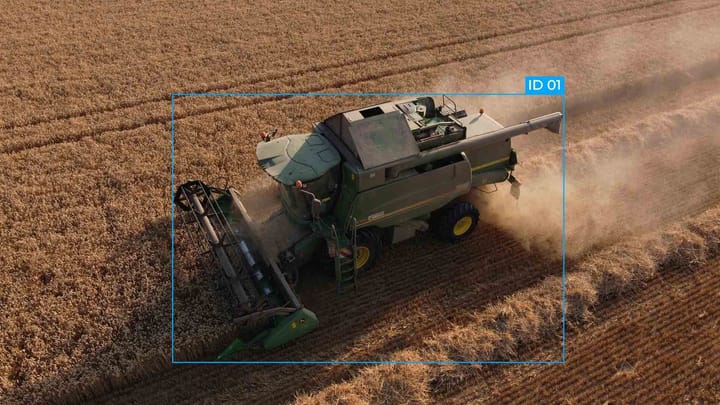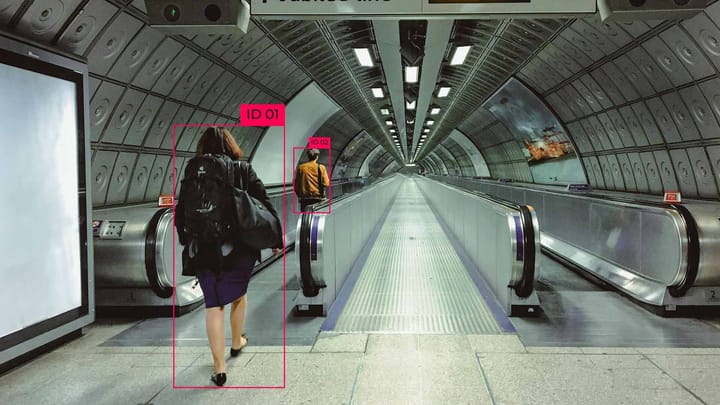From Clicks to Insights: How Segment Anything Computer Vision Can Boost Your Marketing Strategy

Segment Anything Model (SAM), developed by Meta AI, can generate masks for over 500 objects from a single image without prior training. This innovation leverages advanced image analysis to transform marketing strategies with computer vision. SAM offers real-time processing after an initial setup, set to revolutionize computer vision in marketing, providing unmatched marketing insights.
With SAM, marketers can effortlessly extract detailed shapes from any item in an image, significantly improving marketing campaign precision. By identifying and segmenting relevant objects with just a click, you can refine your visual content. This ensures their efforts are more targeted towards specific audiences.
Meta AI’s SAM is distinguished not just by its advanced technology but also by its accessibility. Its open-source nature and the largest segmentation dataset ever created—the Segment Anything 1-Billion mask dataset (SA-1B)—facilitate easy integration into diverse applications. This broadens its impact across various sectors.
To explore SAM's full potential and learn practical strategies for its use, consider delving into further educational resources. For instance, the Google Digital Marketing & E-commerce Professional Certificate offers valuable insights into mastering digital marketing and e-commerce. This ensures you remain competitive in a rapidly evolving market.
Key Takeaways
- SAM effortlessly segments over 500 objects in an image without prior training examples, making image analysis more efficient.
- It provides real-time processing for enhanced marketing insights.
- The model supports seamless integration into various marketing strategies and applications.
- Open-source and equipped with the expansive SA-1B dataset, SAM democratizes access to advanced image segmentation.
- Using SAM can drastically improve the precision and effectiveness of visual marketing campaigns.
Introduction to Segment Anything Model (SAM)
The Segment Anything Model (SAM) marks a leap forward in image segmentation, courtesy of Meta AI. This model excels in pinpointing and isolating objects within images and videos with precision. SAM's standout feature is its interactive approach, utilizing point selection and bounding boxes for seamless object segmentation. Its versatility and open-source nature position it as a key driver of Meta AI innovation in computer vision.
What is SAM?
SAM is an advanced instance segmentation model, employing zero-shot inference and foundation models similar to those in natural language processing. Meta’s FAIR lab developed this model, featuring an image encoder, a prompt encoder, and a mask decoder. The image encoder downscales the original image to 64x64 dimensions with 256 channels. SAM utilizes convolutional neural networks (CNNs) and the CLIP text encoder for precise segmentations.
Key Features of SAM
- Flexible Prompt Encoder: The encoder adapts to different prompts, employing CNNs for masks, positional embeddings for points and boxes, and the CLIP text encoder for text prompts. This yields a 256-dimensional vector output.
- Fast Mask Decoder: SAM's decoder maps image and prompt embeddings into an output mask through two layers. Advanced techniques like self-attention and cross-attention enhance mask generation.
- Training and Data: SAM was trained on a dataset of roughly 1 billion masks across 11 million images. This extensive training enables zero-shot performance and object identification without additional fine-tuning.
- Robust and Scalable: SAM demonstrates exceptional adaptability and robustness, efficiently handling complex scenes with multiple objects and varied backgrounds. Its scalability makes it ideal for managing large datasets and complex tasks, driving Meta AI innovation.
- Wide-ranging Applicability: SAM's versatility spans various sectors like medical imaging, autonomous vehicles, retail, e-commerce, security, and surveillance. It serves as a foundational tool for numerous industry applications.
The Segment Anything Model emerges as a pivotal solution, offering reliability and scalability for companies. By harnessing the capabilities of SAM technology, you can significantly improve your image segmentation efforts across diverse domains.
Understanding Image Segmentation in Computer Vision
In the field of computer vision, grasping the essence of image segmentation is crucial. This technique breaks down images into distinct regions or objects, enhancing analysis efficiency. It's vital in applications like medical imaging, autonomous driving, and more.
Definition and Importance
At the heart of computer vision, image segmentation is a fundamental process. It cuts an image into parts for better understanding and processing. There are several types, including instance, semantic, and panoptic segmentation. This method's value lies in improving the accuracy of tasks like object recognition and location detection.
For instance, in medical imaging, precise segmentation aids in pinpointing tumors or other anomalies.
Image segmentation importance has surged with modern techniques, leading to enhanced performance across various fields.
Traditional vs. Modern Segmentation Methods
Traditional methods, like thresholding and edge-based segmentation, heavily relied on manual input and data preprocessing. While effective, they faced challenges with complex or noisy images, offering moderate accuracy and limited flexibility.
Recently, modern segmentation techniques have emerged, spearheaded by deep learning. Models such as convolutional neural networks (CNNs) have shown high efficiency and accuracy. Datasets like PASCAL VOC, MS COCO, Cityscapes, and ADE20K have played a crucial role in training these models, providing millions of annotations for learning.
The MS COCO dataset, for example, contains 2.5 million labeled instances across 328,000 images, aiding in object detection, segmentation, and captioning. Cityscapes offers essential data for semantic and dense pixel annotations, crucial for autonomous driving.
The shift from traditional to modern segmentation marks a significant leap in accuracy and efficiency. SAM utilizes over a billion annotations, significantly reducing the setup required by traditional methods. This advancement is crucial for applications demanding high precision and rapid processing, making modern techniques transformative in image segmentation.
Delve into the best practices in image segmentation for computer vision to see how these advancements are revolutionizing the industry.
The Technology Behind SAM
The Segment Anything Model (SAM) uses advanced technologies to revolutionize image segmentation. At its core, SAM benefits from deep learning and AI transformers. These technologies enhance efficiency and accuracy in visual data analysis.
Deep Learning and Transformers
Deep learning in computer vision is central to SAM's ability to identify and segment objects in images. It incorporates architectures like Convolutional Neural Networks (CNNs), Generative Adversarial Networks (GANs), and ResNet and VGG models. This integration extends transformers' application from text analysis to visual data interpretation. The SAM network design automatically generates segmentation masks for all objects in an image, ensuring precise and swift data processing.
Zero-Shot Learning
Zero-shot learning is a crucial aspect of SAM, enabling it to recognize new objects without prior training. This capability is essential in artificial intelligence in marketing, where identifying new patterns and trends can offer businesses a competitive advantage. By using multi-modal models like CLIP, SAM can recognize and segment diverse objects across various contexts, enhancing its versatility and utility.
Handling Diverse Data
SAM's architecture is designed to handle a broad spectrum of data, including large private datasets. For example, its SA-1B dataset contains over 1.1 billion masks from 11 million images, significantly boosting its ability to process diverse visual data. This flexibility is beneficial across numerous applications, from urban planning and agriculture to scientific research and marketing. SAM's efficiency is evident in its ability to create mask boundaries almost instantly, processing objects in images in just 50 milliseconds. Such rapid processing times are crucial in artificial intelligence in marketing, where real-time insights can inform more effective decisions.
| Technology or Feature | Key Capabilities |
|---|---|
| Deep Learning and AI Transformers | Improves efficiency and accuracy in visual data interpretation |
| Zero-Shot Learning | Identifies new objects without prior training |
| Diverse Data Handling | Processes large datasets, providing flexibility across various applications |
Applications of SAM in Marketing
The Segment Anything Model (SAM) has revolutionized marketing by harnessing advanced computer vision to refine various marketing tactics.
Optimizing Target Audience Segmentation
One key SAM application in marketing is enhancing audience segmentation. It accurately pinpoints distinct demographic and psychographic groups. This deep dive into audience characteristics allows companies to tailor their marketing efforts precisely.
Such targeted campaigns lead to higher engagement and conversion rates.
Enhancing Visual Marketing Campaigns
SAM boosts visual marketing by segmenting images with precision. Marketers can now craft visuals that resonate deeply with specific audience segments. High-quality, bespoke visuals grab attention more effectively, boosting user interaction and brand recall.
Real-Time Insights and Analytics
SAM application in marketing also offers real-time analytics. It analyzes images and visual content instantly, providing marketers with insights into customer behavior and preferences. This capability enables swift adjustments to marketing strategies, leading to more dynamic and effective campaigns.
Segment Anything in Marketing
Integrating SAM into your marketing efforts can significantly boost user engagement and interaction. This is achieved through diverse and immersive technologies.
User Engagement and Interaction
SAM enables marketers to craft highly personalized user engagement strategies. With precise segmentation, marketing messages can be tailored to specific groups, ensuring high relevance. This approach optimizes offerings to meet audience needs, leading to increased participation and interaction.
- Homogenous needs
- Distinct characteristics
- Common responses to tactics
Predictable responses come from well-defined market segments. These segments are driven by characteristics like interests, lifestyle, and demographics. They facilitate efficient targeting and the effective use of marketing resources.
Augmented Reality and Interactive Content
SAM excels in augmented reality in marketing and creating interactive marketing content. Automatic segmentation and rapid mask generation blend computer vision with AR experiences. This approach captures attention and encourages active participation, making campaigns more engaging.
For example, travel companies can use AR to let potential customers "experience" destinations before booking. Retail brands can offer virtual try-ons. The possibilities are vast, offering a fertile ground for brands to innovate and stand out.
As a result, integrating SAM leads to immersive experiences that elevate your campaigns. These experiences drive higher user engagement and deliver real-time insights. By combining market segmentation and AR, you can create interactive content that deeply resonates with your audience.
Advantages of Using SAM for Marketing
Integrating the Segment Anything Model (SAM) into your marketing strategy boosts your efficiency significantly. SAM brings unmatched speed and accuracy, flexibility for scaling, and substantial cost cuts. These benefits make it a crucial tool for today's marketing needs.
Speed and Accuracy
SAM excels with its lightning-fast performance and exact object segmentation. This is crucial for real-time marketing, such as tracking customer behavior and placing dynamic ads. With over a billion segmentation masks, SAM can quickly and accurately distinguish between various objects. This boosts the quality and targeting of your campaigns.
Scalability and Flexibility
SAM's scalability and flexibility position it as a robust marketing tool. It can manage diverse data types and large datasets with ease. Whether you're tackling detailed market analysis or large-scale advertising, SAM can be customized to meet your needs. This makes it invaluable for businesses of any size.
Cost Reduction
Using SAM also leads to more cost-effective marketing strategies. Automation of the segmentation process cuts down manual labor, resulting in significant savings. Its fast annotation speed enables quicker campaign deployment, enhancing efficiency.
| Feature | Benefit |
|---|---|
| Speed and Accuracy | Enhances targeting precision and campaign quality |
| Scalability and Flexibility | Adapts to various marketing tasks across all business sizes |
| Cost Reduction | Reduces manual labor and operational costs |
Integration of SAM with Existing Tools
Integrating Meta AI’s Segment Anything Model (SAM) with your current marketing tools can transform your digital marketing. SAM's open-source nature and pre-trained models make integration easy. This leads to a notable boost in real-time computer vision insights, enhancing efficiency and targeting precision.
Traditional model training and deployment involve manual processes that are complex and error-prone. Tasks like writing Dockerfiles and configuring endpoints in Amazon SageMaker are time-consuming and often lead to mistakes. SAM integration centralizes these processes, offering a streamlined, scalable approach to model deployment and fine-tuning.
SAM's effectiveness is evident with its 1.1 billion masks and 11 million images in its training dataset. This dataset ensures the model's speed and accuracy in segmentation. It significantly cuts down annotation time, a major cost in developing perception systems. This means marketing professionals can tackle more complex, creative challenges.w.
Functions like `create_sagemaker_deployment()` simplify deploying models on SageMaker, enabling real-time, serverless, and asynchronous inference. This integration boosts productivity and ensures reproducibility and traceability in your marketing platform. AI in digital marketing platforms becomes more powerful with SAM integration, offering enhanced scalability and efficiency across various tools and applications.
FAQ
What is the Segment Anything Model (SAM)?
The Segment Anything Model (SAM) is a cutting-edge tool by Meta AI for precise object identification in images and videos. It uses interactive methods like point selection and bounding boxes for object segmentation. It also automatically generates segmentation masks.
What are the key features of SAM?
SAM's key features include segmenting over 500 objects in complex images instantly. It offers real-time processing after an initial setup. It also has zero-shot learning to identify new objects without prior training. Additionally, its open-source nature fosters collaboration within the AI community.
How does SAM improve traditional image segmentation methods?
SAM enhances traditional image segmentation by leveraging over one billion annotations for superior performance. It requires minimal setup and offers high accuracy. This significantly reduces the time and effort needed for image segmentation.
What role does deep learning and transformers play in SAM?
Deep learning and transformers are crucial to SAM's functionality. It employs technologies like CNNs, GANs, ResNet, and VGG for efficient image segregation. Transformers enable SAM to extend its applications beyond text to visual data, facilitating advanced image analysis and segmentation.
How does SAM handle diverse data and new objects?
SAM's zero-shot learning capability allows it to identify new objects without prior training. It uses multi-modal models like CLIP to handle a wide array of data, including large private datasets. This showcases its adaptability and flexibility in various marketing scenarios.
How can SAM optimize target audience segmentation in marketing?
SAM enables precise target audience segmentation by providing detailed visual insights. Its point-based annotations and boundary-creating capabilities allow marketers to gather tailored analytics instantly. This refines their understanding of their audience and enhances campaign effectiveness.
What are the benefits of integrating SAM into visual marketing campaigns?
Integrating SAM into visual marketing campaigns enhances user engagement through augmented reality experiences and interactive content. Its automatic segmentation and rapid mask generation facilitate the incorporation of computer vision into marketing strategies. This drives user interaction and engagement.
How does SAM provide real-time insights and analytics?
SAM processes prompts via natural language, offering real-time insights and analytics. This capability equips marketing professionals with robust tools to shape campaigns that deeply resonate with their audience. It ultimately improves engagement and the effectiveness of marketing initiatives.
What are the advantages of using SAM for marketing?
SAM offers high-speed performance and pinpoint accuracy in object segmentation. It is scalable and flexible, accommodating vast datasets, making it suitable for businesses of all sizes. SAM also reduces manual labor and speeds up annotation processes, proving cost-efficient for dynamic marketing endeavors.
Are there real-world case studies showcasing SAM's success?
Yes, real-world case studies show SAM's impact across various industries, including medical imaging, satellite imagery, and Neural Radiance Fields (NeRF). These successful implementations highlight SAM's value in AI and analytical applications. They provide valuable insights for enhancing advertising campaigns and data-driven marketing strategies.
How can SAM be integrated with existing marketing tools and platforms?
Integrating SAM with existing marketing tools and platforms is straightforward due to its open-source nature and availability of pre-trained models and code under the Apache 2.0 license. This adaptability enriches digital marketing ecosystems, enhancing sophisticated tools with advanced image segmentation capabilities. It fosters seamless marketing workflows.



Comments ()